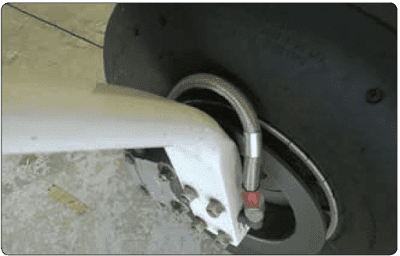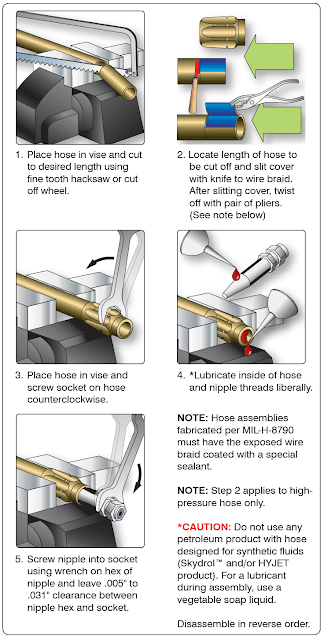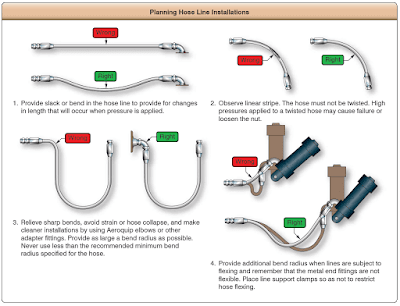Flexible hose is used in aircraft fluid systems to connect moving parts with stationary parts in locations subject to vibration or where a great amount of flexibility is needed. It can also serve as a connector in metal tubing systems.
RELATED POSTS
Hose Materials and Construction
Pure rubber is never used in the construction of flexible fluid lines. To meet the requirements of strength, durability, and workability, among other factors, synthetics are used in place of pure rubber. Synthetic materials most commonly used in the manufacture of flexible hose are Buna-N, neoprene, butyl, ethylene propylene diene rubber (EPDM) and Teflon™. While Teflon™ is in a category of its own, the others are synthetic rubber.
Buna-N
Buna-N is a synthetic rubber compound that has excellent resistance to petroleum products. Do not confuse with Buna-S. Do not use for phosphate ester base hydraulic fluid (Skydrol™).
Neoprene
Neoprene is a synthetic rubber compound that has an acetylene base. Its resistance to petroleum products is not as good as Buna-N, but it has better abrasive resistance. Do not use for phosphate ester base hydraulic fluid (Skydrol™).
Butyl
Butyl is a synthetic rubber compound made from petroleum raw materials. It is an excellent material to use with phosphate ester base hydraulic fluid (Skydrol™). Do not use with petroleum products.
Flexible rubber hose consists of a seamless synthetic rubber inner tube covered with layers of cotton braid and wire braid and an outer layer of rubber-impregnated cotton braid. This type of hose is suitable for use in fuel, oil, coolant, and hydraulic systems. The types of hose are normally classified by the amount of pressure they are designed to withstand under normal operating conditions: low, medium, and high.
- Low pressure—below 250 psi. Fabric braid reinforcement.
- Medium pressure—up to 3,000 psi. One wire braid reinforcement. Smaller sizes carry up to 3,000 psi. Larger sizes carry pressure up to 1,500 psi.
- High pressure—all sizes up to 3,000 psi operating pressures.
Flexible hoses used for brake systems have sometimes a stainless steel wire braid installed over the hose to protect the hose from damage. [Figure 1]
Hose Identification
Lay lines and identification markings consisting of lines, letters, and numbers are printed on the hose. [Figure 2] Most hydraulic hose is marked to identify its type, the quarter and year of manufacture, and a 5-digit code identifying the manufacturer. These markings are in contrasting colored letters and numerals that indicate the natural lay (no twist) of the hose and are repeated at intervals of not more than 9 inches along the length of the hose. Code markings assist in replacing a hose with one of the same specifications or a recommended substitute. Hose suitable for use with phosphate ester base hydraulic fluid is marked Skydrol™ use. In some instances, several types of hose may be suitable for the same use. Therefore, to make the correct hose selection, always refer to the applicable aircraft maintenance or parts manual.
Teflon™ is the DuPont trade name for tetrafluoroethylene resin. It has a broad operating temperature range (−65 °F to +450 °F). It is compatible with nearly every substance or agent used. It offers little resistance to flow; sticky, viscous materials do not adhere to it. It has less volumetric expansion than rubber, and the shelf and service life is practically limitless. Teflon™ hose is flexible and designed to meet the requirements of higher operating temperatures and pressures in present aircraft systems. Generally, it may be used in the same manner as rubber hose. Teflon™ hose is processed and extruded into tube shape to a desired size. It is covered with stainless steel wire, which is braided over the tube for strength and protection.
Teflon™ hose is unaffected by any known fuel, petroleum, or synthetic base oils, alcohol, coolants, or solvents commonly used in aircraft. Teflon™ hose has the distinct advantages of a practically unlimited storage time, greater operating temperature range, and broad usage (hydraulic, fuel, oil, coolant, water, alcohol, and pneumatic systems). Medium-pressure Teflon™ hose assemblies are sometimes preformed to clear obstructions and to make connections using the shortest possible hose length. Since preforming permits tighter bends that eliminate the need for special elbows, preformed hose assemblies save space and weight. Never straighten a preformed hose assembly. Use a support wire if the hose is to be removed for maintenance. [Figure 3]
Flexible Hose Inspection
Check the hose and hose assemblies for deterioration at each inspection period. Leakage, separation of the cover or braid from the inner tube, cracks, hardening, lack of flexibility, or excessive “cold flow” are apparent signs of deterioration and reason for replacement. The term “cold flow” describes the deep, permanent impressions in the hose produced by the pressure of hose clamps or supports.
When failure occurs in a flexible hose equipped with swaged end fittings, the entire assembly must be replaced. Obtain a new hose assembly of the correct size and length, complete with factory installed end fittings. When failure occurs in hose equipped with reusable end fittings, a replacement line can be fabricated with the use of such tooling as may be necessary to comply with the assembly instructions of the manufacturer.
Fabrication and Replacement of Flexible Hose
To make a hose assembly, select the proper size hose and end fitting. [Figure 4] MS-type end fittings for flexible hose are detachable and may be reused if determined to be serviceable. The inside diameter of the fitting is the same as the inside diameter of the hose to which it is attached. [Figure 5]
Flexible Hose Testing
All flexible hose must be proof-tested after assembly and applying pressure to the inside of the hose assembly. The proof-test medium may be a liquid or gas. For example, hydraulic, fuel, and oil lines are generally tested using hydraulic oil or water, whereas air or instrument lines are tested with dry, oil-free air or nitrogen. When testing with a liquid, all trapped air is bled from the assembly prior to tightening the cap or plug. Hose tests, using a gas, are conducted underwater. In all cases, follow the hose manufacturer’s instructions for proof-test pressure and fluid to be used when testing a specific hose assembly. [Figure 6]
When a flexible hose has been repaired or overhauled using existing hardware and new hose material, and before the hose is installed on the aircraft, it is recommended that the hose be tested to at least 1.5 system pressure. A hydraulic hose burst test stand is used for testing flexible hose. [Figure 7] A new hose can be operationally checked after it is installed in the aircraft using system pressure.
Size Designations
Hose is also designated by a dash number according to its size. The dash number is stenciled on the side of the hose and indicates the size tubing with which the hose is compatible. It does not denote inside or outside diameter. When the dash number of the hose corresponds with the dash number of the tubing, the proper size hose is being used. [Figure 2]
Hose Fittings
Flexible hose may be equipped with either swaged fittings or detachable fittings, or they may be used with beads and hose clamps. Hoses equipped with swaged fittings are ordered by correct length from the manufacturer and ordinarily cannot be assembled by the mechanic. They are swaged and tested at the factory and are equipped with standard fittings. The detachable fittings used on flexible hoses may be detached and reused if they are not damaged; otherwise, new fittings must be used. [Figure 8]
Installation of Flexible Hose Assemblies
Slack
Hose assemblies must not be installed in a manner that causes a mechanical load on the hose. When installing flexible hose, provide slack or bend in the hose line from 5 to 8 percent of its total length to provide for changes in length that occurs when pressure is applied. Flexible hose contracts in length and expands in diameter when pressurized. Protect all flexible hoses from excessive temperatures, either by locating the lines so they are not affected or by installing shrouds around them.
Flex
When hose assemblies are subject to considerable vibration or flexing, sufficient slack must be left between rigid fittings. Install the hose so that flexure does not occur at the end fittings. The hose must remain straight for at least two hose diameters from the end fittings. Avoid clamp locations that restrict or prevent hose flexure.
Twisting
Hoses must be installed without twisting to avoid possible rupture of the hose or loosening of the attaching nuts. Use of swivel connections at one or both ends relieve twist stresses. Twisting of the hose can be determined from the identification stripe running along its length. This stripe should not spiral around the hose.
Bending
To avoid sharp bends in the hose assembly, use elbow fittings, hose with elbow-type end fittings, or the appropriate bend radii. Bends that are too sharp reduce the bursting pressure of flexible hose considerably below its rated value. [Figure 9]
Clearance
The hose assembly must clear all other lines, equipment, and adjacent structure under every operating condition.
Flexible hose should be installed so that it is subject to a minimum of flexing during operation. Although hose must be supported at least every 24 inches, closer supports are desirable. Flexible hose must never be stretched tightly between two fittings. If clamps do not seal at specified tightening, examine hose connections and replace parts as necessary. The above is for initial installation and should not be used for loose clamps.
For retightening loose hose clamps in service, proceed as follows:
- Non-self-sealing hose—if the clamp screw cannot be tightened with the fingers, do not disturb unless leakage is evident. If leakage is present, tighten one-fourth turn.
- Self-sealing hose—if looser than finger-tight, tighten to finger-tight and add one-fourth turn. [Figure 10]
Hose Clamps
To ensure proper sealing of hose connections and to prevent breaking hose clamps or damaging the hose, follow the hose clamp tightening instructions carefully. When available, use the hose clamp torque-limiting wrench. These wrenches are available in calibrations of 15 and 25 in-lb limits. In the absence of torque-limiting wrenches, follow the finger-tightplus-turns method. Because of the variations in hose clamp design and hose structure, the values given in Figure 10 are approximate. Therefore, use good judgment when tightening hose clamps by this method. Since hose connections are subject to “cold flow” or a setting process, a follow-up tightening check should be made for several days after installation.
Support clamps are used to secure the various lines to the airframe or powerplant assemblies. Several types of support clamps are used for this purpose. The most commonly used clamps are the rubber-cushioned and plain. The rubber-cushioned clamp is used to secure lines subject to vibration; the cushioning prevents chafing of the tubing. [Figure 11] The plain clamp is used to secure lines in areas not subject to vibration.
A Teflon™-cushioned clamp is used in areas where the deteriorating effect of Skydrol™, hydraulic fluid, or fuel is expected. However, because it is less resilient, it does not provide as good a vibration-damping effect as other cushion materials.
Use bonded clamps to secure metal hydraulic, fuel, or oil lines in place. Unbonded clamps should be used only for securing wiring. Remove any paint or anodizing from the portion of the tube at the bonding clamp location. Make certain that clamps are of the correct size. Clamps or supporting clips smaller than the outside diameter of the hose may restrict the flow of fluid through the hose. All fluid lines must be secured at specified intervals. The maximum distance between supports for rigid tubing is shown in Figure 12.












